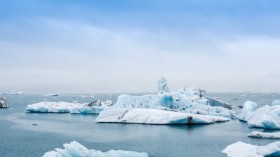Using decades of research on geology, ancient climates and evolutionary relationships, Duke University's Richard Kay has helped to explain how primates migrated and evolved in the Western Hemisphere.
"We know from molecular studies that the monkeys have their closest relatives in Africa and Asia - but that doesn't explain how they got to South America, just that they did," said Kay, who teaches in the school's evolutionary anthropology department and division of earth and ocean sciences.
Primates evolved after the South American land mass parted ways with Africa, and based on the lack of monkey ancestor fossils in North America, it's unlikely that there was ever any kind of southward migration. Other options include traversing the seas on some kind of raft or making their way more gradually across islands long since buried under the waves.
"However they got to South America, they were evolving in the Amazon Basin, and from time to time they managed to get out of the basin," Kay said. "So if you want to learn about what was going on in the Amazon, you have to look at its periphery."
After some 25 years of digging around in places like Chile, Kay has discovered an array of monkey fossils that he used to piece together a more detailed history of their evolution in the region. In all, the researcher used nearly 400 different features of teeth, skulls and skeletons from 16 living and 20 extinct monkey species from Africa and South America to build a family tree that he then compared to a second one made from molecular studies of living species.
With only a few exceptions, the two trees closely resembled each other - a discovery that, Kay said, adds a great deal of credence to the use of fossils' anatomies to draw conclusions.
"The gold standard is molecular evidence," he said. But genetic material deteriorates over time, and at this point, anatomy is "the only tool we have." Though, Kay noted, "it does a pretty good job."
In particular, Kay's study focuses on figuring out how and when monkeys made their way to the Caribbean islands and South America's deep south located just 600 miles from Antarctica and thousands of miles from where today's monkeys roam. Looking at long-term changes in the region's ancient climate, Kay discovered that mountain-building and sea level fluctuation could explain the evolutionary pattern seen in the fossils.
The study also explains why those lineages that evolved outside the Amazon Basin failed to last: The Patagonian climate eventually turned arid and cold, causing the primates there to go extinct, while those in the Caribbean died off during the last 6,000 years apparently due to sea level rise and the arrival of humans. The analysis submits that rather than coming from Central America, these monkeys came from South America, having floated there by chance.
The study was published in the journal Molecular Phylogenetics and Evolution.
© 2024 NatureWorldNews.com All rights reserved. Do not reproduce without permission.





